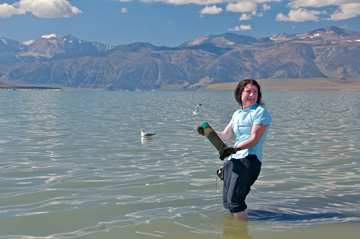While for days rumors have circulated around the Internet that NASA had discovered alien life, the truth may be even less expected. Instead of aliens, NASA-funded researchers have discovered a microorganism on Earth that breaks all the rules of life: in Mono Lake in California scientists found a bacterium that can survive wholly on arsenic. The microorganism is capable of replacing phosphate, one of the essential blocks of all known life, with the toxic chemical arsenic according to new researched published in Science. Uncovered by lead author and NASA-funded scientist, Felicia Wolf-Simon, along with astrobiolgist colleagues at Arizona State University, the discovery is thought to have widespread implications on how life may survive on other planets.
“Life as we know it requires particular chemical elements and excludes others,” explains co-author Ariel Anbar, a biogeochemist and astrobiologist who directs the astrobiology program at Arizona State University. “But are those the only options? How different could life be?”
 The alien-like landscape of Mono Lake, California. Image © 2010 Henry Bortman. |
Very, very different it turns out. Arsenic is usually highly toxic to life by disrupting metabolic pathway, however chemically arsenic acts similarly to phosphate. The extremophile bacteria, a member of the Halomonadaceae family, is capable of switching out phosphorous for arsenic to such an extent that the arsenic is actually incorporates it into its DNA.
“Arsenic is toxic mainly because its chemical behavior is so similar to that of phosphorus. As a result, organisms have a hard time telling these elements apart. But arsenic is different enough that it doesn’t work as well as phosphorus, so it gets in there and sort of gums up the works of our biochemical machinery,” explains Anbar.
The concept that arsenic could replace phosphorous was first proposed by Wolf-Simon in a paper published last year in the International Journal of Astrobiology. Then she turned to the lab to prove it.
“We not only hypothesized that biochemical systems analogous to those known today could utilize arsenate in the equivalent biological role as phosphate,” says Wolfe-Simon “but also that such organisms could have evolved on the ancient Earth and might persist in unusual environments today.”
 Wolfe-Simon in the field collecting samples at Mono Lake. Here she has just pulled up a push core of sediments (mud) from the bottom of the lake. This core will provide starters for cultures to which researchers will add high doses of arsenic. Image © 2010 Henry Bortman. |
Wolf-Simon found her organism in bizarre Lake Mono in California, already known to be home to odd life-forms like trillions of tiny brine shrimp that lives no-where else. The salty alkaline lake was chosen in part because it sports high levels of arsenic.
After collecting microorganisms from the lake, Wolf-Simon and colleagues grew the bacteria, dubbed strain GFAJ-1 of the Halomonadaceae family of Gammaproteobacteria, in Petri dishes in the laboratory. First they provided their microscopic charges with all the phosphate salt they could need, but slowly the researchers added arsenic to the mix and took away the phosphate until the bacteria was thriving entirely off arsenic. Still, the scientists had to confirm that the bacteria had completely switched out the need for phosphorous with arsenic. With high-tech radio-tracers the scientists followed the arsenic into the bacteria’s cells, until they found that the arsenic replaced phosphate so fully as to incorporate itself into the bacteria’s DNA. While the discovery gives ‘adaptation’ a new name, the researchers say life could go further yet.
“This organism has dual capability. It can grow with either phosphorous or arsenic. That makes it very peculiar, though it falls short of being some form of truly ‘alien’ life belonging to a different tree of life with a separate origin. However, GFAJ-1 may be a pointer to even weirder organisms. The holy grail would be a microbe that contained no phosphorus at all,” says co-author Paul Davies.
Wolf-Simon concludes that “this story isn’t about arsenic or Mono Lake”. Instead, she says, “if something here on Earth can do something so unexpected, what else can life do that we haven’t seen yet? Now is the time to find out.”
On her website www.ironlisa.org, Wolf-Simon hints: “this is only the beginning”. No doubt the world will be watching closely.
Related articles
Video: no sunlight, no food, frozen conditions, but NASA finds complex life
(03/16/2010) In a discovery at the bottom of the world that could have implications on the search for extraterrestrial life, researchers were astounded to find an amphipod swimming beneath a massive Antarctic ice sheet.
Biological shocker: snake reproduces asexually
(11/03/2010) Researchers have discovered a biological shocker: female boa constrictors are capable of giving birth asexually. But the surprise doesn’t end there. The study in Biology Letters found that boa babies produced through this asexual reproduction—also known as parthenogenesis—sport a chromosomal oddity that researchers thought was impossible in reptiles.
Photos: weird new species discovered in deep sea trench

(10/18/2010) Fish were not expected to be able to survive so deep, but scientists have captured footage of a new species of a scavenger-hunting snailfish swimming at an astounding 7,000 meters below the surface. The video, taken from an 8,000 meter-deep sea trench in the Southeast Pacific Ocean, showed a level of biodiversity that surprised seasoned marine biologist, who have previously surveyed five other deep sea trenches.
Amazing reefs: how corals ‘hear’, an interview with Steve Simpson

(07/21/2010) Corals aggregate to form vast reefs, which are home to numerous species and provide vital ecological services such as protecting shorelines. However, coral reefs are one of the most threatened ecosystems in the world due to many factors, such as global warming and ocean acidification. Recent research by Simpson and his team of scientists has shown that corals, rather than drifting aimlessly after being released by their parent colonies and by chance landing back on reefs, instead find their way purposefully to reefs by detecting the sound of snapping shrimps and grunting fish on the reef. However, that discovery also means that the larvae might struggle to find reefs when human noises, like drilling or boats, mask the natural ocean sounds.
Uncovering the intelligence of insects, an interview with Lars Chittka
(06/29/2010) Many people would likely consider ‘insect intelligence’ a contradiction in terms, viewing insects—when they think of them as anything more than pests—as something like hardwired tiny robots, not adaptive, not intelligent, and certainly not conscious. However, research over the last few decades have shown that a number of well-studied insects are capable of performing amazing intellectual feats, from recognizing individuals to employing a symbolic language in a behavior known as a ‘bee waggle’. “Already in 1900, Buttel-Reepen asked whether honeybees are mere reflex machines—and emphatically denied that claim,” Dr. Lars Chittka, professor of Sensory and Behavioral Ecology at Queen Mary University in London, told mongabay.com in an interview. “Over the last century, we have seen a fundamental change in perspective on the learning capacities of insects, and there a now several credible lines of evidence that insects are capable of cognitive feats that had previously been ascribed only to ‘higher’ vertebrates”.
Close to a billion species: ocean exploration reveals shocking diversity of tiny marine life

(04/19/2010) Biologists worldwide may have to start re-evaluating their estimates of the number of species on Earth, since expeditions documenting the oceans’ tiniest species have revealed shocking diversity: in the tens of millions of species, at least, and according to one researcher “closer to a billion”. Fourteen field projects sent out by the Census of Marine Life focused on the oceans’ smallest inhabitants: microbes, zooplankton, and tiny burrowing species inhabiting the deep sea bed. What they found was astounding.
Scientists discover world’s first amphibious insects: Hawaiian caterpillars
(03/22/2010) Scientists have never before discovered a truly amphibious insect until now: writing in the Proceedings of the National Academy of Sciences researchers have announced the discovery of 12 species of Hyposmocoma moths in the Hawaiian islands which they consider truly amphibious—that is a species able to survive both on land and underwater indefinitely.
